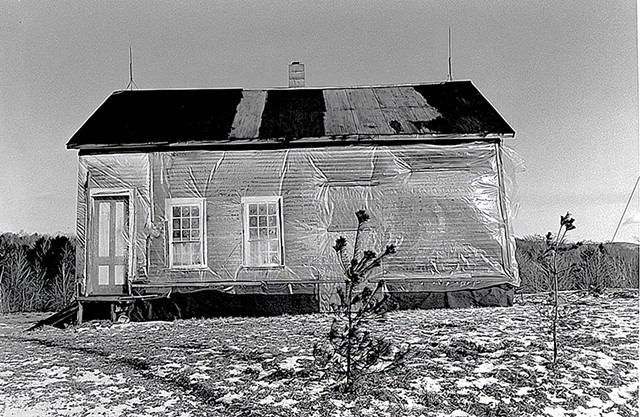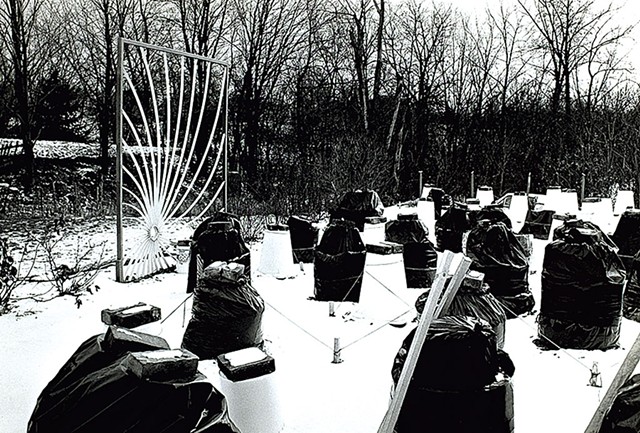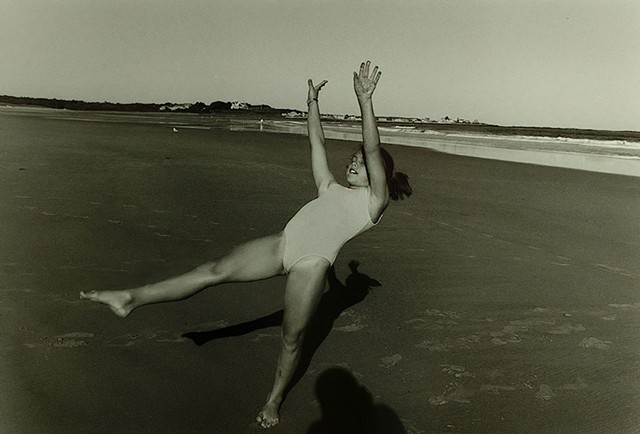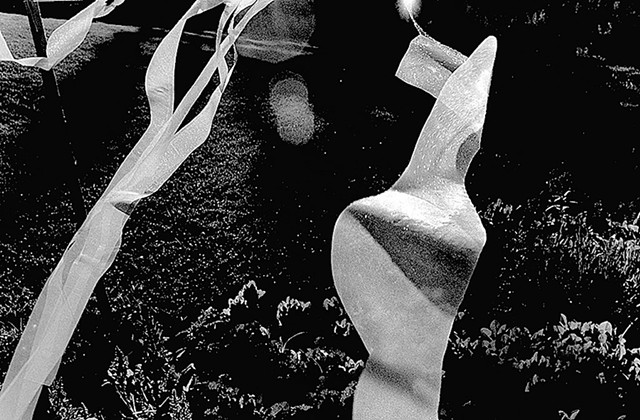
- Courtesy
- "Wrapped house Waterville, VT" by Peter Moriarty
This summer, BigTown Gallery in Rochester reopened after a long, pandemic-induced hiatus. During that time, gallerist Anni Mackay and her husband, Doon Hinderyckx, were not exactly idle: The couple bought a nearby 19th-century building and transformed it into the Stable Inn.
Beautifully furnished and sustainably powered, the inn has already offered respite to travelers, including bicycle touring groups — Hinderyckx owns the adjacent retail and repair shop Green Mountain Bikes. But Mackay has her eye on another use for the inn in the near future: a site for artist and multidisciplinary residencies.
Meantime, she has reopened BigTown Gallery with its first all-photography exhibit. Collectively titled "No Place Like Here," it has three sections: black-and-white silver gelatin images by Peter Moriarty, taken in Vermont primarily in the 1980s and recently reprinted; four prints from the Farm Security Administration collection of the Library of Congress that Moriarty purchased for his teaching portfolio; and another selection of 17 Vermont-specific FSA photos.
Moriarty, 70, lives in Clinton, Mass., but has had a long association with Vermont. After earning an MFA in photography at the Rochester Institute of Technology in 1979, he taught for 18 years at Vermont colleges. With a federal grant, he created the bachelor of fine arts program at Johnson (now part of Vermont State University) and for a time served as its chair.

- Courtesy
- "Jericho, VT" by Peter Moriarty
Moriarty eventually left Vermont to print black-and-white images for Print Zone in New York City — one client was renowned portrait photographer Annie Leibovitz — and to teach at two New York schools before retiring in 2012. Through the years, he kept up his own photography practice — mostly with analog film and darkroom printing — and produced a couple of books. Copies of his 2019 volume, Warm Room: Photographs From Historic Greenhouses, are available at BigTown.
Most of the photos Moriarty selected for the current exhibit hew to a surprising theme: plastic. It's natural for a present-day viewer to expect some environmental commentary. But Moriarty's rural Vermont pictures were taken decades before we learned about the Great Pacific Garbage Patch and microplastics in our bloodstreams and how to sort our recyclables. His stark images show farm buildings, houses and gardens shrouded in plastic for thermal support in winter.
"I think the language we would use today is 'adaptive reuse,'" Moriarty said in a phone conversation. "[It's] what people have done to adapt to the climate. Vermonters pride themselves on their resilience."
Viewers who harbor an antiplastic stance might experience an interesting psychological shift to witness the material as utilitarian rather than as waste. In "Miller garden Johnson, VT" (Moriarty's titles are sparing), two white feed bags shield tomato plants from frost; in the twilight gloom, they might be ghostly trick-or-treaters in a darkened yard. Conversely, black plastic-wrapped somethings in "Jericho, VT" loom in a snowy field like sculptures.
"Wrapped house Waterville, VT" evokes Christo, though even that wrap-happy artist, who died in 2020, probably wouldn't have braved rural Vermont in January.

- Courtesy
- "Mirah Kennebunk, ME" by Peter Moriarty
This and other structures encased in plastic illustrate an aesthetic phenomenon, too: light modulation. "Plastic amplifies the light striking the building," Moriarty explained. For a photographer enthralled by film's deep blacks, crisp whites and delicate permutations of gray, the sources and reflections of light are paramount considerations.
Moriarty expressed the same interest in his pictures of cut plastic. Unlike the straightforward rural views, these are abstract and harder to parse. The photographer sliced sheets of clear plastic, painted on them, hung them on clotheslines outdoors and shot them billowing in the wind. From across the room, "July 22, 1985" could be a painting of enigmatic shapes cavorting against a dark field. "July 19, 1984" looks like strange botanical life forms reaching for the sky.
Moriarty included in this exhibit three prints from a series that has nothing to do with plastic: "The Hurt Dance: Photographs of Endurance Athletes." The figurative works depict competitive swimmers in and out of water, as well as his own swimsuit-clad daughter, Mirah, angled toward a backward somersault on a beach. That was 1990; Mirah later became a professional dancer, Moriarty said.
Moriarty's photos alone reward visitors to BigTown; including Farm Security Administration photographs was not necessary, but they do add dimension to the show's title.

- Courtesy
- "Cut Plastic 4" by Peter Moriarty
The FSA was a U.S. government program that ran from 1937 to 1946 as part of an effort to combat rural poverty during the Depression. The Library of Congress houses the thousands of images collected during those years and, as they are in the public domain, they are available for purchase. Moriarty bought some photos printed from original negatives to use in his classes on the history of photography. One of them was arguably the most famous Depression-era image: Dorothea Lange's 1936 "Migrant Mother." This hangs in BigTown along with two photos by Walker Evans and one by Ben Shahn.
The Vermont-centric FSA pictures — which are digital copies — might be even more intriguing to local viewers. Moriarty had a special interest in works by women, who — surprise, surprise — often did not get due credit in their lifetimes. One of these was Louise Rosskam, who spent some time in Lincoln. Her 1940 pictures in this selection document a farm, a band concert, a traveling silver salesman and the "Oldest woman in Lincoln."
In the batch of Vermont photos, one was actually taken in Nipomo, Calif., by Lange. The 1935 image captures a couple of "Pea Pickers From Vermont" standing outside a tent with a jalopy that apparently made the cross-country trip. The caption indicates that they earned $7 for six weeks' work. "It calls into question who is a migrant," Moriarty observed.
All the photographs in "No Place Like Here" ask a viewer to contemplate the special gravity of belonging.









Comments
Comments are closed.
From 2014-2020, Seven Days allowed readers to comment on all stories posted on our website. While we've appreciated the suggestions and insights, right now Seven Days is prioritizing our core mission — producing high-quality, responsible local journalism — over moderating online debates between readers.
To criticize, correct or praise our reporting, please send us a letter to the editor or send us a tip. We’ll check it out and report the results.
Online comments may return when we have better tech tools for managing them. Thanks for reading.